Many will opt for aspirin at the first sign of discomfort. Today I want to share some foods that not only taste good, but that have been shown to ease discomfort in the body and improve overall health as well.

Most people will experience bodily discomfort at some point in their lives, and some will rely on medication – which can be a slippery slope – a method that may simply mask symptoms, never getting to the root cause of the problem.
The best part is:
You may already have some of these foods on hand in your home. If not, they’re all fairly easy to find.
Below you’ll learn about these foods, what each is best known for, and a few ways you can start using them right away.
I’ve found whole foods to be very beneficial for natural healing, and I turn to them first for curing what ails my own body, as well as soothing the pain of the ones I love.
I’m sure you’ll recognize a few of the items below. Keep in mind that in order for them to be effective, you have to include them in your daily diet.
Pay attention to the “Try this” section, as I’ll share some helpful tips on how to consume each food.
Always remember to consult with a physician or health care professional before making any major changes to your diet.
#1 – Blueberries
These small berries are extremely high in antioxidants, which is one property you’ll want to increase when battling discomfort. The more antioxidants, the less inflammation, which translates to less irritation.
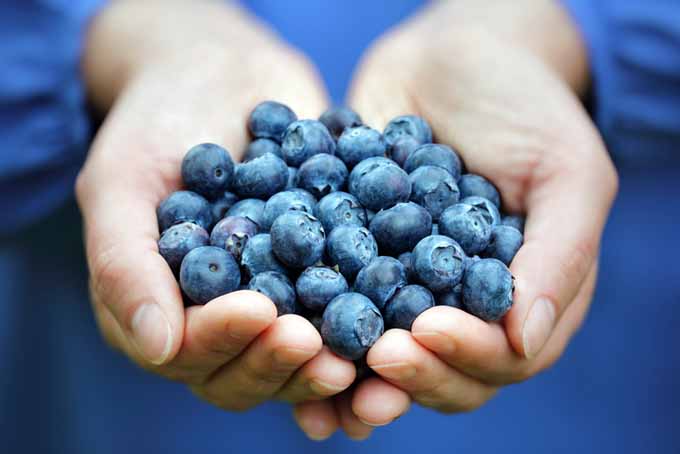
Blueberries contain flavonoids called anthocyanins, which are responsible for the somewhat sour taste and their bright blue color.
Anthocyanins contain ant-inflammatory and antioxidant properties. Scientists have found that the effect of the flavonoids may be more powerful than aspirin.
According to chiropractic physician, acupuncturist and nutritionist Dr. Scott Schreiber of the Delaware Back Pain and Sports Rehabilitation Center, who stated that “flavonoids have a multifaceted beneficial effect on the body, especially as we grow older.”
“They increase the level of heat-shock proteins, which decrease as we age” Schreiber says. “As the level is increased, the level of inflammation is reduced, decreasing discomfort and preventing tissue damage.”
Blueberry bushes can grow all over the U.S. In fact, 38 states grow these berries every year.
Curious whether you live in a top producing state? Most of these berries come from:
- Michigan
- Oregon
- Washington
- Georgia
- New Jersey
- California
In terms of a growing season, fresh blueberries are available year round, if they are imported at least part of the year.
If you live in North America, the season runs from April-October. In South America, the productive period for this crop runs from November-March.
The good news is, fresh or frozen, both seem to have the same positive effect on treating irritation. I couldn’t find a study that recommended fresh over frozen, which makes sense, as flash-freezing is a great way to preserve nutrients.
That being said, if these berries happen to be out of season in your area, go for the frozen variety. It’s suggested that you have 1/2-1 cup each day to get the full benefits.
Try This:
I recommend adding them to a smoothie, sprinkling them on top of some yogurt, or mixing them in with your oatmeal.
You can even add them to your salads or, heck, eat them alone as a snack!
Storage:
Store fresh blueberries in an airtight container inside your refrigerator. They will keep for 4-7 days in there, or you can store them in the freezer for 6-8 months.
Additional Tip:
If you’re trying to freeze fresh blueberries, lay them out flat on a baking sheet and freeze them for 2-3 hours. Once frozen, transfer them to a zip-top bag – this will keep them from sticking together.
#2 – Cherries
When it comes to cherries, you want to consume the tart variety.
According to Michael Downey at LifeExtension magazine, tart cherries have been shown to significantly reduce the pain and loss of strength induced by exercise, and decreased muscle function recovery times.

Tart cherries, also called Montmorency cherries, are consumed in the U.S. – and they are primarily grown in Michigan, which is considered the “Cherry Capital” of the world. However, you can also find them growing in Utah, Washington, New York, Wisconsin and Pennsylvania.
Although they’re harvested in July, you probably won’t find them fresh unless you live in one of the growing regions mentioned above.
If you can’t find these, you should be able to locate products that contain cherries, like tart cherry juice. This is especially popular right now in the endurance sports arena.
New lab studies have found cherries to be very beneficial in combating irritation and inflammation.
It’s not just athletes who can benefit, though. Dr. Schreiber says cherries have been shown to help relieve discomfort in patients with gout, a very uncomfortable form of arthritis.
Try This:
I recommend adding tart cherries and tart cherry juice to your smoothies. You can also add the juice to sparkling water or kombucha with a little sweetener, to make a refreshing tonic.
Storage:
If you do get your hands on some fresh ones, store them in a bag in your fridge, or inside an airtight container. They will keep for 5-7 days. If you can only find the juice or other products, follow the instructions on the package.
Additional Tip:
It’s best to go with the juice on this one. While the exact number of cherries you need to consume to see results is up for debate, 1 tablespoon of tart cherry juice is equivalent to 40-60 cherries. But that’s a lot of cherries to eat, if you plan on keeping up with this habit every day.
#3 – Garlic
This well known remedy happens to be one of the oldest medicinal foods on the planet. It’s been used for centuries to treat aches and pains: things like toothaches, back problems, and chest discomfort.
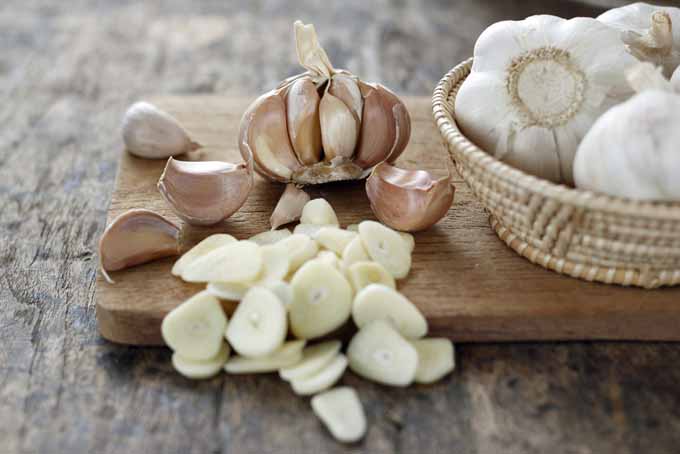
Garlic is often referred to as a superfood due to the presence of a medical compound called allicin. Allicin is actually what gives garlic its potent smell, which is most prominent when the garlic is chopped, crushed or chewed.
If you want to get the most out of your garlic, be sure to chop it up first.
Garlic is anti-inflammatory as well as being antibacterial and antifungal, making it great not only for soothing aches, but effective in helping to beat the common cold and fungal infections. Studies have also shown it to be effective at lowering blood pressure.
Try This:
I’m sure you’re already eating garlic pretty frequently, but just in case, here are some of my favorite ways to include it in your diet:
- Sauté 1-2 cloves before adding it to your favorite tomato sauce.
- Add 1-2 minced cloves to your favorite salad dressing.
- Use it to season proteins, or your favorite vegetables.
Storage:
Garlic does best when it’s stored in a dry, dark space at around 60-65°F with moderate humidity, so a drawer or cabinet works well. See Foodal’s Complete Guide on Garlic Storage for more details.
Additional Tip:
You can freeze garlic, too. Simply peel and toss the cloves in a food processor with a little water, pour the mixture into ice cube trays, and freeze. Pop a frozen cube or two into the sauté pan to flavor pasta dishes and stir fries.
This little trick works well for many herbs and you can read more about it in our complete guide to preserving herbs.
#4 – Ginger
This is a personal favorite of mine. I love using this herb anytime I have an upset stomach. Recently, I’ve been using it to beat inflammation in my lower back as well.
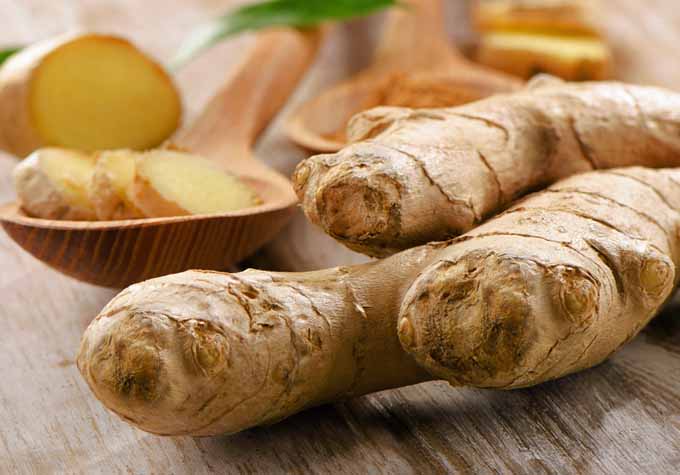
One medical study showed that the consumption of raw, and even cooked ginger resulted in significantly less physical discomfort in those who suffered from an exercise-induced injury.
I’m not surprised, as I’ve experienced similar results myself. The wonderful thing about ginger is that it’s fast acting – if you’re consistent, you may see an improvement quickly.
Ginger has also been shown to be helpful for reducing knee aggravation in people suffering from osteoarthritis.
Try This:
If you’re unsure of how to get this medicinal herb into your diet, I have a few suggestions (and here are a few more).
Include freshly peeled ginger in your juice and smoothie recipes. You can also use the fresh root in salad dressings and stir fries, or the powdered variety in baked goods.
Storage:
You can store fresh ginger in a plastic bag, just be sure to remove all of the air. If you do that, it will keep for about 2-3 weeks.
Ginger can also be washed, cut into one-inch segments, and frozen for 1-2 months – just pull out what you need, and let it defrost a bit on the counter before mincing or grating.
Additional Tip:
Easily peel fresh ginger using a spoon – it’s more efficient and effective than a vegetable peeler.
#5 – Green Tea
Here’s another food that’s loaded with antioxidants. Are you noticing a theme?
Yes, it’s true that antioxidants are a key factor that may contribute to pain relief. One study concluded that green tea is an excellent natural remedy in beating joint discomfort.
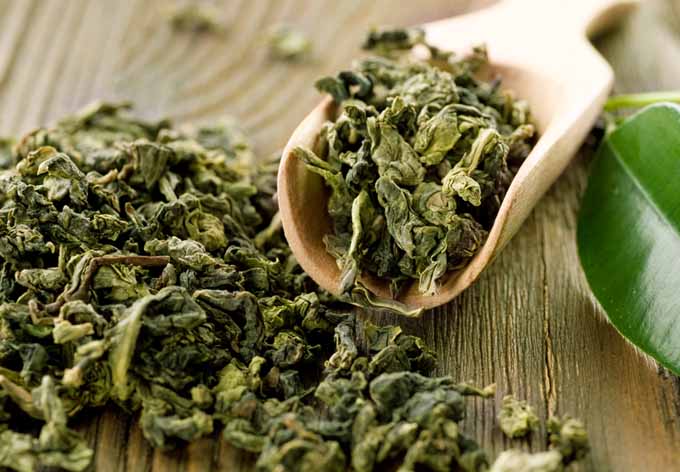
Many people who suffer from arthritis are turning to this ancient Chinese tradition for a healthier alternative to soothe their joints.
The special qualities of this tea may also contribute to weight loss, natural energy, and stabilizing blood pressure.
Similar to coffee, green tea does contain caffeine. However, it’s a smaller quantity that’s released at a slower speed, giving you more sustainable energy and less jitters.
Try This:
Pick up a box at your local grocery store, and start drinking a cup in the morning for a little boost, or in even the afternoon.
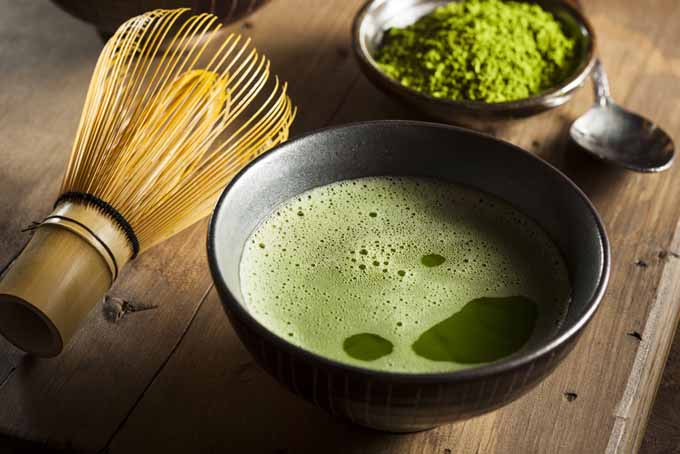
You can also invest in some matcha powder, made from ground tea leaves. Matcha is wonderful to include in your baking, smoothies, or even in savory stews or gravy.
Storage:
Store green tea or matcha in a dark, dry place. I keep mine with my other teas in a cabinet.
Additional Tip:
For the perfect cup of green tea, heat your water to about 170°F and allow the leaves to steep for 2-3 minutes. See Foodal’s Complete Guide to Green Tea for more details.
#6 – Holy Basil
This herb has been used in China for over 5,000 years to battle inflammation, stress, and even radiation poisoning. Hindus consider this to be a magical plant that can cure disease and beat illness.
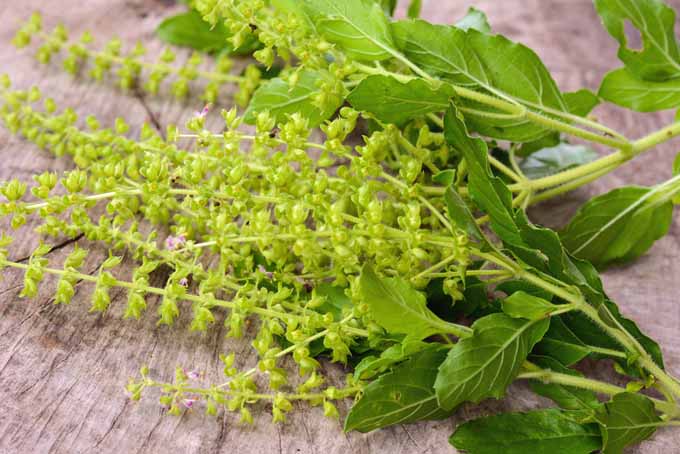
Also known as tulsi, with the scientific name ocimum tenuiflorum, this herb is known for treating a host of illnesses such as fever, headaches, asthma, lung disorders, heart disease, muscle strains, and stress.
“It is very popular herb in Ayurveda and has been used to treat headaches in folk medicine,” say Dr. Schreiber.
The herb is antibacterial as well as antifungal, and its healing properties come from the essential oils and phytonutrients this plant contains.
Now, before you reach for the basil that you have in the refrigerator, I must warn you that holy basil is a little different than regular basil.
While they’re both a part of the mint family, these are actually different plants. Though similar in appearance, but tulsi is usually greyish-green in color, with a stronger flavor.
Try This:
You’ll often find holy basil in premade teas. Try adding 1-2 cups a day for up to 2 weeks for the most benefit. You can also buy this herb in capsule form and take it as a daily supplement.
Storage:
If using the tea, store in a dark, dry place. And if taking as a supplement, simply follow the manufacturer’s instructions.
Additional Tip: You can grow tulsi just like you would regular basil. Look for it where seeds are sold.
#7 – Chili Peppers (Spicy)
When it comes to chili peppers, the real benefit comes from capsaicin – the active ingredient that produces a warm feeling when applied to the skin.
“It depletes ‘Substance P,’ a compound shown to transmit pain signals to the brain,” reports Rebecca Lee, a registered nurse with a background in holistic medicine.

Seems ironic, but the very intense burning feeling you get when you eat spicy peppers is actually responsible for alleviating discomfort as well.
If you can handle the heat (and don’t have an inflamed colon), spicy peppers are a great tool to use in relieving discomfort from intestinal ulcers and heartburn. They’re also useful for easing joint and muscle pain.
If you’re familiar with capsaicin, Lee says “…it’s an active ingredient in many over-the-counter pain relieving medications. And the cream is commonly used to soothe arthritic aches and open wounds.”
Try This:
Foods like cayenne peppers, chili peppers, hot sauce and kimchi are all great options. Mexican and Thai are two cuisines that take advantage of the power of chili peppers often, so try to eat more of these types of foods.
Storage:
Store fresh chili peppers in an airtight container in the refrigerator, and they keep for 3-5 days. Keep dried chilies in a sealed container somewhere dark – if stored correctly, they can last up to 4 months.
We recommend keeping your spices organized and away from heat and light by storing them in one of our recommended spice racks. Check out our review of the top models here.
Additional Tip:
In general, the smaller and more pointed the pepper is, the spicier it is.
#8 – Mint
This herb will do a lot more than freshen your breath – it will melt away discomfort all throughout your body.
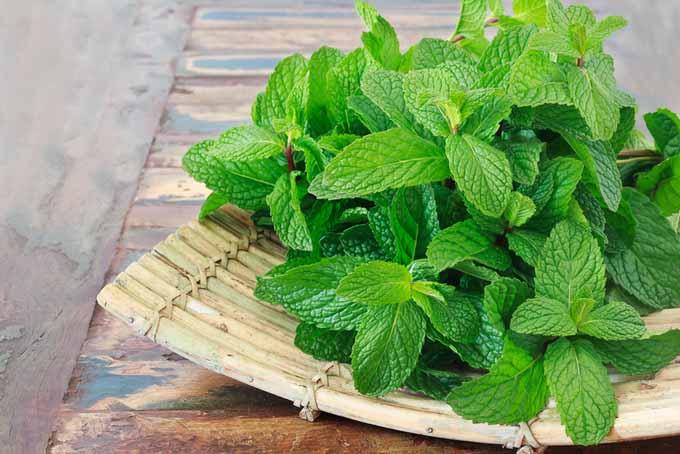
Peppermint can be used to combat stomachaches, since the menthol helps to prevent muscle spasms.
Use wintergreen to reduce tension in the back – the methyl salicylate helps to block enzyme-causing inflammation in the body.
Try This:
Add fresh mint leaves to salads, smoothies, and even dessert recipes. You can also steep fresh or dried peppermint and wintergreen leaves in a mug of hot water to create a flavorful tea, or simply use the store-bought version.
Storage:
There are two ways that you can store fresh mint:
- Wrap mint loosely in a damp paper towel, then place that into a zip-top bag – but don’t seal the bag all the way, allowing air to circulate
- Trim the ends and place the mint in a glass with 1-2 inches of water, and cover the tops with a bag. If you go with this second option, be sure to change the water frequently.
Fresh mint will last for about 7-10 days.
Additional Tip:
You can apply peppermint or wintergreen essential oils topically to places where you’re experiencing discomfort. Just be sure to dilute the oils with a carrier, test them on a small area first to rule out an adverse reaction, and keep them away from your eyes and other sensitive parts.
#9 – Pineapple
This juicy fruit, often bragged about in the health space thanks to its amazing vitamin C content, has recently gained popularity for something else – bromelain. This is the group of enzymes that are found in pineapple, shown to decrease inflammation and help ease discomfort, mostly in joints.
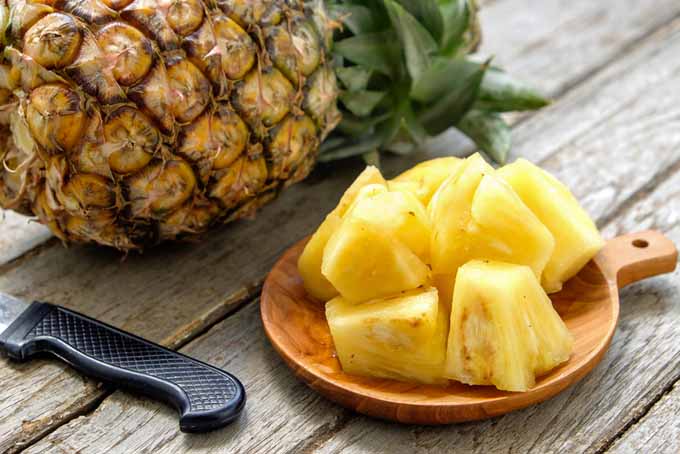
As if you needed another reason to dig into this sweet, juicy fruit, not only does it taste great, but it’s wonderful for helping to get rid of excessive inflammation and digestive issues.
As Lee states, it’s great for boosting your immune system, too (can’t forget that vitamin C!).
Try This:
Add it to a green salad, or even a fruit salad. Blend it up in a smoothie, juice it in your juicer, or grill it on the barbecue.
Storage:
Keep whole pineapples on the counter or in the refrigerator for 2-3 days. Once cut, store in an airtight container in the refrigerator for 1-2 days.
Additional Tip:
Be sure to use the core, as a lot of the nutrients hide in the center of the pineapple. If you have a high speed blender or a good juicer, the core will easily break down along with the rest of the fruit.
#10 – Sage
Sage is fairly easy to come by, as it’s one of the more popular culinary herbs. It’s in the mint family, and is closely related to rosemary.
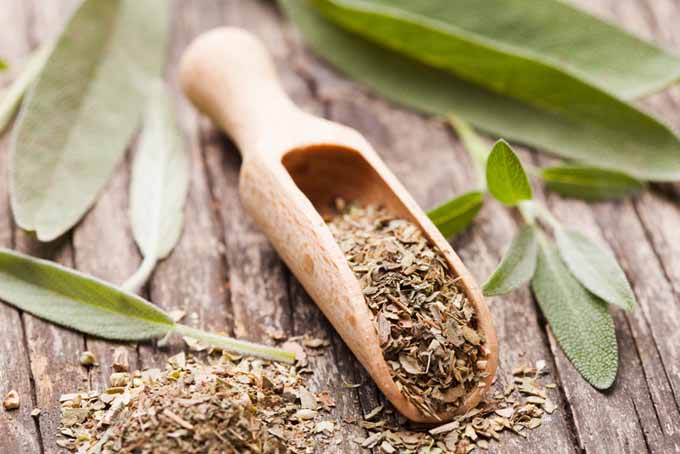
This herb has been used in many different cultures over time to ease various miseries in the body.
Very common throughout history is its ability to combat inflammation, and oral health problems such as gum disease.
Sage is also said to be useful for easing menstrual complaints. According to R. Y. Langham, Ph.D, a staff contributor to livestrong.com, it has been shown to be useful in minimizing bloat in the stomach area, easing heavy flow, and improving symptoms of depression due to its cooling and calming effects.
Try This:
Add a few tablespoons of minced fresh sage to a roast, or even roasted potatoes. Also try adding the dried variety to season rice or grilled kabobs.
You can even apply it topically by making a soothing balm – simply add a few drops of sage essential oil to your favorite lotion.
Storage:
Fresh sage leaves will stay fresh for 3-4 days if they are wrapped in a damp paper towel and stored in the refrigerator. Dried sage should be kept in an airtight container in a dark and dry spot.
Additional Tip:
If you live in a climate where you can grow sage (not too hot or humid), look for the pineapple variety for extra discomfort relief – it offers elements of both pineapple and sage that can have a cooling effect on the body.
#11 – Turmeric
I may have saved the best for last: turmeric.
Using this is a great way to manage discomfort. Curcumin, the active ingredient in turmeric that’s responsible for the relief of inflammation in the body, has been getting a lot of press over the past two years.
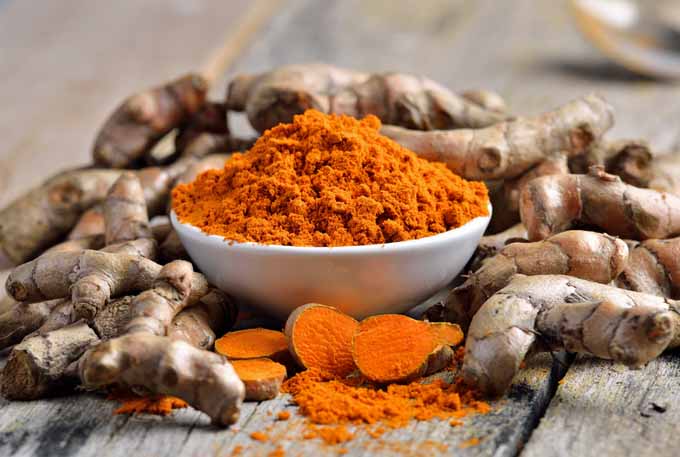
This spice was once known mainly for the bright yellow color that it added to curry dishes. Now, it has a newfound reputation for beating discomfort and inflammation.
“Turmeric is treasured for its ability to expedite wound healing [while reducing scar tissue] and relieve arthritis inflammation,” reports Lee.
A quick peek into your local health food store will reveal lots of new turmeric-based products like turmeric green juice, elixirs, and even brain-boosting energy shots. My advice is to skip these mass-produced products and go straight to the source – the real thing.
Turmeric looks very similar to ginger, sometimes a bit smaller, and it grows like a root with light brown skin. The main visual difference is under that skin – once peeled, it is bright orange.
Beware, it stains hands and surfaces easily!
If you haven’t given it a try, it might be time. The potential health benefits of turmeric are definitely attracting a lot of followers – it’s becoming a movement!
Try This:
Turmeric will always have a place in spicy curry dishes and soups, but it’s time for something different – try adding fresh turmeric to your water instead. Simply peel away the skin and finely dice it before tossing it in.
Or, add the dried powder to your baked goods – I’ve made a few loaves of turmeric banana bread that received rave reviews – just add 1-3 teaspoons of ground turmeric to your favorite recipe.
Storage:
Keep dried turmeric in a cool, dark place – like a spice rack or drawer – and fresh turmeric in the refrigerator, where it will keep for 1-2 weeks. For additional protection, you can wrap fresh turmeric in a paper towel and place it in a zip-top plastic bag before storing.
Additional Tip:
Now that turmeric is growing in popularity, you should be able to find the fresh root in the produce section of most grocery stores. If not, there’s always turmeric powder in the spice department.
If you have any trouble locating it, try your local Asian or Indian grocery – these stores tend to offer a variety of fresh and dried spices.
Conclusion
I hope you found this list helpful, and maybe you’ll reach for some of these foods next time your back or knee starts aggravating you. Personally, I plan to add more tart cherry juice to my natural remedy toolkit.
I’d love to hear if you’ve noticed any relief from these foods. Or maybe you’re interested in trying some of them? Leave a comment below and let me know.
The staff at Foodal are not medical professionals and this article should not be construed as medical advice. Foodal and Ask the Experts, LLC assumes no liability for the use or misuse of the material presented above. Always consult with a medical professional before changing your diet or using supplements or manufactured or natural medications.
Photo Credits: Shutterstock
About Sarah Hagstrom
Sarah is a health food advocate and loves to spend her time whipping up something healthy and delicious in the kitchen and then sharing either on Foodal or on her own blog "The Seasonal Diet" (www.theseasonaldiet.com). She lives in Sunny San Diego with her husband, where they enjoy running on the beach and weekend adventures.




I love this article! As someone with adenomyosis – pain symptom was a common thing for me in the past. I used to be a painkiller-popper. But having resolved to stop popping pills, I can generally say that it’s worth looking into these natural foods. Sometimes all one needs is to change one’s diet. As for me, it was the red meats that I minimized eating (especially beef) that I think helped me. I no longer have pain symptoms due to dietary changes. I love garlic and pineapples. They’re always part of my diet. I didn’t know of their painkilling capacity until now, but probably they too helped in my becoming pain free. I still have adenomyosis, but at least I’m pain-free now.
I’m glad to hear you liked this article. I completely agree with you – Our diet does play a big role in the amount of pain we feel. I’m glad to hear you’re feeling better 🙂
This is a great list, I was pleased to see that I already use a lot of these items in my cooking! Garlic, ginger, and chili peppers are some of my favourite ingredients, especially in stir fry and curries. I’ll try to keep this is mind and give a few of these a try before I go for the aspirin next time 🙂 I always like giving natural remedies a shot, especially when they’re as delicious as some of these are 😉
Sounds like you’re on the right track. Try adding some of the others into your diet and let us know how it goes!
Wow! Such an informative article! My head is going to burst with all this juicy information. I’m printing this out and putting it on my refrigerator door ASAP. Thanks a lot for helping us learn about these cool super foods and the tips on how we can integrate them into our routines. For example I will occasionally purchase cherries, blueberries and sage, but I didn’t know about their curative properties. Now, for example with garlic, I use it every single day, and I was totally clueless about that too. I wanted to add, that I’ve heard that Chili can be good for people that are constipated, and can help accelerate our metabolisms. I’ve also heard that it’s good to eat bananas after workouts because they help ease muscle pain. Thanks Sarah, again for another great article!
Hey Michelle!
I’m so happy you found this article helpful. And, thank you for your tips. I’ve heard that about bananas but never looked into it, I should add that to the list! Thank you:)
This article is amazing! I am so glad more and more people are seeing the healing benefits that natural foods and herbs have. I feel like we’ve been eating fast food and junk so long that we forget that these foods are literally super foods! That foods have the ability to heal. I mean that is what people used way before pharmacies were everywhere. I don’t even have aspirin in my house because we use a combination of herbs to heal our headaches naturally. Great article!
Verity you’re totally right. Food as medicine seems to be gaining popularity. I’m very excited about this as well!
What a very interesting article! I never really thought of food as something that can “heal” or alleviate pain or other health issues, so it’s interesting to see all the different foods that can help. Even better, most of the foods on this list aren’t even unpleasant tasting! I can definitely eat garlic and blueberries and pineapples all day, so the added health benefits are simply a plus.
Yes, some of the most delicious foods are indeed some of the most beneficial in fighting discomfort.
I was having a headache this morning, and instead of reaching for my ibuprofen I actually made a vegetable soup, (kale, carrots and spinach). I used some of the left over broth I had from my beef stew and made sure to include some ginger, garlic and about a tablespoon of red pepper flakes, (yes, it was very spicy). I keep these spices in my cabinet often, but I don’t know what compelled me to use them today. So far, my headache is still there, but not nearly as severe.
Hi Spiceoflife,
Sometimes food can take longer to produce results, give it time. I will say, that soup sounds amazing! I like spicy foods as well:)
Wow!! This is fantastic. I can really put this information to good use. The best part is that I like most of these, and most of them are readily available (not so sure about turmeric). I will share this info as well, since I know some others that it could help.
Thanks so much for putting this all together in such a great format. I’ll bookmark it and refer to it often.
Hi Zyni!
We’d love it if you shared this article. As for the turmeric, check your produce department for the fresh variety, and also your spice section for the dried variety. I’m confident you can find some:)
I will do that, thanks. I’m not so sure though. I live out in the country. We don’t have access to lots of stuff, including many items that seem common to other people. I might be able to find some in the city in one of the bigger stores though.
I will definitely share it. If I or anyone can benefit this much just by making some painless dietary changes that is good news indeed.
Well the saying is, Let Food Be Thy Medicine and that’s the way I look at health too. In my household 65% to 70% of my grocery shopping is a whole foods diet and I’m still a work in progress. I’m really working to get my numbers higher. I’m hoping to expand on my garden so I’ll have more food to freeze and can.
At one time, my children thought I practiced some kind of magic because I always seemed to have a remedy to help their pain or sickness. I would laugh and just tell them, that it’s not “magic” but it’s called a home remedy. I have several jars of herbs that I’ve grown from my garden in my cabinets and I feel truly blessed to have a culinary /medicine cabinet in my kitchen.
I love that story! I also follow a whole food diet and It makes a world of difference. Good luck with your garden expansion:)
Wow, this article is fantastic. So useful! Many of the items listed in the article I was aware of having great health benefits, but cherries and blueberries were a couple that I was not aware of. I am definitely going to try implementing these ingredients into more foods.
I love this article! My mother has Multiple Sclerosis, and I am always trying to find foods that help fight pain and inflammation to include in our diet. I was familiar with the benefits of some foods on the list (like blueberries), but not all of them. I had never heard of Holy Basil.
Ginger is another ingredient that I have not worked with much. I am looking forward to trying out these foods, many of which I already have on hand. However, I am going o look for recipes that include these ingredients to make them a regular part of mine and my mothers diet,
Thoughts and prayers for your mom. It’s nice that you are trying to find simple ways to help her. I think it makes it much nicer when you can simply add some fruit or herbs to your diet instead of adding yet another medication.
I already told a relative of mine about this article. He has severe problems with his knees, so I thought the ginger part would be interesting to him. He likes ginger and is a good cook, so that’s a plus.
We use most of these herbs and spices. We use garlic for stomach related complications, ginger for cough and cold,
green tea to boost mood, holy basil for physical pain and turmeric for many complications such as cold, cough, physical pain etc. Ginger, turmeric and garlic are our basic cooking ingredients.
I regularly use ginger, hot peppers, and green tea to relieve pain.
I found ginger to be excellent for any kind of tummy pain or nausea. I usually grate it and boil it in water for about 20 minutes. Sometimes I add some organic honey. It brings relief pretty fast.
Hot peppers (habaneros, or just a very strong chili powder) are a great way to fight sore throat. I find that the burning they produce actually feels quite nice to me, and numbs my throat. Makes it easier to eat and swallow, and I have a feeling it helps with infection too.
Lastly, I drink a ton of green tea when I have a bladder infection. For some reason, it works well to take away the burning pain. In most cases, the infection is gone in two days and I’m back to normal.
It absolutely fascinates me when I read about all of the different things that our food can do for us, and it is always amazing when we find things that can make us feel better. I know that a lot of foods contain antioxidants for example, and by eating those we are much healthier within ourselves. It is amazing that there are ingredients that can be used as painkillers – and I suffer from regular headaches myself, so I will be taking advice from this article and trying out some of natural cures that you suggest as pain relief, as this is something that I feel could help me at this point in my life.
While I haven’t read anything here that would allow most people to just replace the aspirin so to speak some of the ideas do have some merit. Reducing the overall inflammation levels day to day in the body and eating healthier are good things even if they wont actually do much for most real pain issues.
As a registered nurse who has been to rural areas with no direct/fast access to modern medicine, this is an excellent list. We have been taught about the natural and alternative treatments to common ailments such as nausea, headache, and insomnia, while studying, and this article definitely complements what I have learned. It is truly amazing though, that simple root crops or beverages have a great effect on the human body. Special mention to tea, as there are countless types out there in the market. A simple research can give you specific tea solutions to your problems, such as insomnia (Chamomile), colds (Elder Flower), stress (Lemon Balm), nausea (Ginger Tea), and many more.
Good list, when using natural food as medicine the keys are quantity and quality. The higher the better.
For the brave, crush 3-4 cloves of garlic with a similar quantity of ginger in a pestle and mortar. Adding sea salt will help you to crush the mix into a smooth paste. Add in tumeric and/or cayenne pepper and you have a strong antibacterial/antifungal mix. No need for antibiotics!
Add to your dish sparingly as it packs a real pucnh and will take some getting used to.
Ah, I love how this article states what foods (actually) help fight pain, how to store them and extra tips on using them. I want to state that Holy Basil really does relieve pain, not just psychical but mentally as well. I have anxiety and it’s something I struggle with daily but Holy Basil helps me cope with it. It’s a very strong herb and it works miracles on my body.
It’s amazing what cures and remedies Nature provides for us. My mother suffers with a painful hip – she needs a hip replacement but the budget unfortunately just isn’t there – but she has been adding turmeric to her tea or coffee in the morning, and I also make sure to add some to our salad dressings , and she does get some relief from it. I also incorporate a tiny pinch of black pepper as this helps to make the curcumin more easily absorbed by the body. Wonderful and very comprehensive article. Thank you!